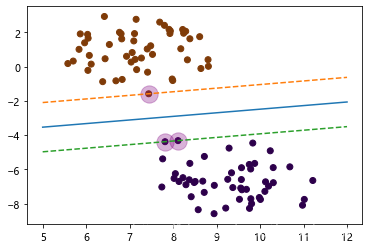文章目录
第一部分:线性问题部分
import numpy as np
import matplotlib.pyplot as plt
%matplotlib inline
from sklearn.svm import SVC
import sklearn.datasets as datasets
1.1、生成随机散点
# 生成一序列的点,默认n_samples=100,中心centers=2
X,y = datasets.make_blobs(n_samples=50,centers=2)
X.shape #结果为(50, 2)
(1)查看X:
array([[10.19536929, -6.98207178],
[ 8.17673749, 1.04956597],
[ 7.11262117, 1.93567167],
[ 7.69201225, 2.6067144 ],
... ...
[ 9.7840538 , -5.97999583],
[ 8.22020804, 2.17484189],
[ 9.52555314, -7.75041062]])
(2)查看y:
array([0, 0, 0, 0, 1, 1, 0, 0, 0, 0, 1, 1, 1, 0, 1, 1, 1, 1, 1, 0, 1, 1,
0, 0, 1, 0, 1, 0, 0, 1, 0, 0, 0, 1, 0, 0, 1, 0, 1, 1, 0, 0, 0, 1,
1, 0, 1, 1, 1, 1])
(3)画散点图:
#导入颜色
from matplotlib.colors import ListedColormap
color = ListedColormap([(1.0,0,0),(0,1.0,0)]) #红色和绿色
X,y = datasets.make_blobs(n_samples=100,centers=2) #生成100个散点,2个中心
plt.scatter(X[:,0],X[:,1],c = y,cmap = color) #散点图可视化

1.2、建模
- 现在需要画一条线把红色和绿色的点分隔开,先进行数据的学习,再确定这条线的截距和系数
- 线性回归方程:
f(X)=w1*x1 + w2*x2 + b=x*w + b_w = -w1/w2b_ = -b/w2
svc = SVC(kernel='linear') #线性模型
svc.fit(X,y) #训练模型
(1)使用 svc.coef_ 获取该线的系数:
w1,w2 = svc.coef_[0]
print (svc.coef_)
print (w1)
print (w2)
[[ 0.14604164 -0.69448342]]
0.146041643741726
-0.6944834196263103
(2)使用 svc.intercept_ 获取截距:
b = svc.intercept_
b
array([-3.18503123])
(3)回归线 f(X) = w1*x1 + w2*x2 + b = x*w + b_ 推导:

(4)支持向量点直线:
- 支持向量点和分隔线平行,所以它们的斜率相等,当
f(x) = -1和f(x) = 1时,可以求出通过支持向量点的两条直线; - 公式:
f(X)=x*w + b1和f(X)=x*w + b2 - 推导过程:
1 = w1*x + w2*y + b
-1 = w1*x + w2*y + b
b1 = -(b + 1)/w2
b2 = -(b - 1)/w2
1.3、数据可视化
plt.scatter(X[:,0],X[:,1],c = y,cmap = plt.cm.PuOr) #原数据散点图
x = np.linspace(5,12,50) #这里的x值可以根据上面随机散点设置
#绘制回归线
plt.plot(x,x*w + b_)
#绘制支持向量点
plt.scatter(support_vectors_[:,0],support_vectors_[:,1],color = 'purple',s = 300,alpha = 0.3)
# 绘制两个支持向量点的直线
plt.plot(x,x*w + b1,ls = '--')
plt.plot(x,x*w + b2 ,ls = '--')

第二部分:非线性问题部分
import numpy as np
import matplotlib.pyplot as plt
%matplotlib inline
from sklearn.svm import SVC
2.1、随机生成数据
X = np.random.randn(300,2) #生成300行2列的随机矩阵
X.shape #结果为(300,2)
plt.scatter(X[:,0],X[:,1]) #绘制散点图

2.2、属性组合分隔数据
- 可以通过数据的属性组合产生新的特征将数据区分出来,如通过它们的象限区分出来它们的属性;
- 第Ⅰ、Ⅲ象限相乘为正, 第Ⅱ、Ⅵ 相乘为负。
# 属性组合
# x3 = x1*x2
x3 = X[:,0] * X[:,1]
y = x3 >=0
#绘制散点图
plt.scatter(X[:,0],X[:,1],c = y)

2.3、建模
# rbf 径向基 高斯分布数据处理
svc = SVC(kernel='rbf')
svc.fit(X,y) #训练学习模型
2.3.1、测试范围
x1 = np.linspace(-3,3,100)
y1 = np.linspace(-3,3,100)
X1,Y1 = np.meshgrid(x1,y1) #网格交叉,X1和Y1都是(100, 100)的矩阵了
#散点图可视化
X_test = np.concatenate([X1.reshape(-1,1),Y1.reshape(-1,1)],axis=-1) #concatenate数据集联
plt.scatter(X_test[:,0],X_test[:,1])

结果分析: 这是结果是正确的。因为这上面有10000个点,分布太多密集。
2.3.2、预测分隔
y_ = svc.predict(X_test) #预测测试
plt.figure(figsize=(5,5)) #设置图像比例
plt.scatter(X_test[:,0],X_test[:,1],c = y_) #作散点图

2.3.3、求它的距离
d_ = svc.decision_function(X_test)
d_
array([0.1093417 , 0.11477454, 0.12075184, ..., 0.16816356, 0.16268286,
0.15759471])
绘制轮廓面:
plt.figure(figsize=(5,5))
plt.contourf(X1,Y1,d_.reshape(100,100)) #轮廓面contourf

结果分析: 颜色越深,说明值越大,离分离超平面越远。
第三部分:SVM回归实战
3.1、准备数据
import numpy as np
import matplotlib.pyplot as plt
%matplotlib inline
from sklearn.svm import SVR
X = np.linspace(0,3*np.pi,50).reshape(-1,1) #转化为二维数据
y = np.sin(X)
plt.scatter(X,y) #画散点图

3.2、建立模型
svr_linear = SVR(kernel='linear') #线性
svr_rbf = SVR(kernel='rbf') #高斯
svr_poly = SVR(kernel='poly') #多项式
svr_linear.fit(X,y)
svr_rbf.fit(X,y)
svr_poly.fit(X,y)
3.3、预测数据及可视化
# 生成测试集
X_test = np.linspace(0, 3*np.pi, 128).reshape(-1,1)
#在模型中预测目标
y1 = svr_linear.predict(X_test) #线性
y2 = svr_rbf.predict(X_test) #高斯
y3 = svr_poly.predict(X_test) #多项式
#可视化
plt.scatter(X,y) #原散点图
plt.plot(X_test,y1)
plt.plot(X_test,y2)
plt.plot(X_test,y3)
plt.legend(['Linear','Rbf','poly']) #显示标签






















 6225
6225











 被折叠的 条评论
为什么被折叠?
被折叠的 条评论
为什么被折叠?








